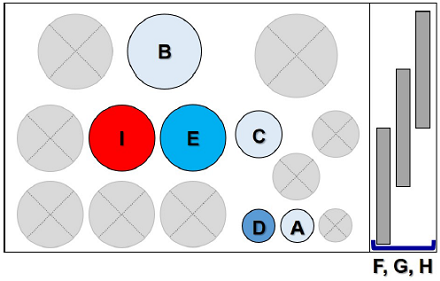General Information
α-Ketoglutarate (α-KG) is an important intermediate of the TCA cycle. It is used as an indicator of enhanced uptake of glucose metabolites into the TCA cycle and of enhanced glutaminolysis, the metabolic pathway for supplying α-ketoglutarate using glutamine as a substrate. α-Ketoglutarate plays an essential role in the production of glutamate and γ-aminobutyric acid (GABA), and contributes to the scavenging of reactive oxygen species. Besides, a recent cancer study suggested that α-ketoglutarate behaves effectively for tumor suppression through the p53 protein1).
α-Ketoglutarate Assay Kit-Fluorometric enables the quantitation of α-ketoglutarate. This kit has been optimized to quantify intracellular α-ketoglutarate by measuring the fluorescence of resorufin generated by an enzymatic reaction. This kit is formatted for 96-well microplates, and it is possible to measure multiple samples.

Figure 1. Principle of α-Ketoglutarate Assay Kit-Fluorometric
Kit Contents
-
α-KG Standard (10mmol/l) (White cap) 300 μl x 1 A Control Buffer 25 ml x 1 B Lysis Solution 2 ml x 1 C ALT Solution (Blue cap) 35 μl x 1 D Reaction Buffer (Blue cap) 5 ml x 1 E Enzyme Mix (Red cap) x 1 F Coenzyme (Yellow cap) x 1 G Fluorescent Dye (Green cap) x 1 H Assay Buffer (Red cap) 6.5 ml x 1 I - This kit corresponds to 12 test samples.
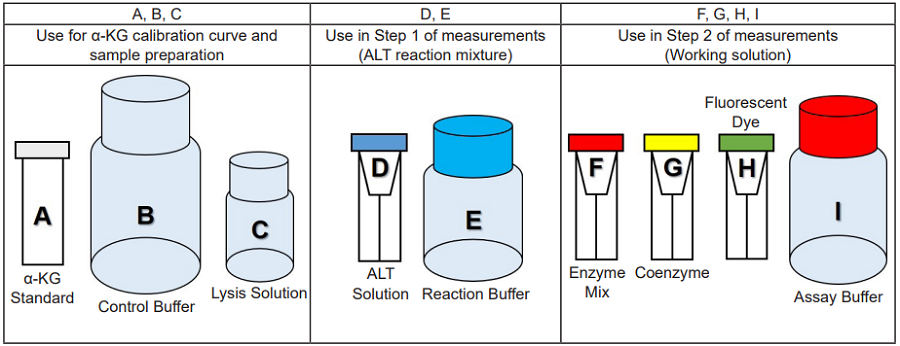
Storage Conditions
Store at 0-5 °C, protect from light.
Required Equipment and Materials
- Fluorescence microplate reader (excitation filter: 530-560 nm, emission filter: 580-600 nm)
- 96-well black plate
- Incubator (37 °C)
- 20-200 μl multichannel pipette
- 100-1000 μl, 20-200 μl, 2-20 μl micropipettes
- Phosphate buffered saline (PBS), dimethyl sulfoxide (DMSO), 10 mmol/l hydrochloric acid (10 mmol/l HCl)
- Conical tube
Precautions
- Equilibrate reagents to room temperature prior to use.
- Briefly centrifuge the tubes containing α-KG Standard (white cap), ALT Solution (blue cap), Enzyme Mix (red cap), and Coenzyme (yellow cap) before opening to remove all content from the walls of the tube and inside the cap.
- Pipette the ALT Solution (used in Step 1 of measurements) before use to ensure the enzyme is homogenous.
- Analysis of samples and standards in triplicate is recommended for accuracy.
- Use a multichannel pipette to dispense the working solution to minimize time lags in pipetting because the enzymatic reaction is initiated immediately upon its addition.
- This kit has been designed for analyzing intracellular α-KG. Prepare samples at different dilutions to determine the most suitable concentration, ranging from 0 to 20 μmol/l α-KG.
Preparation of Solutions
Preparation of Fluorescent Dye stock solution
Add 70 μl DMSO to the Fluorescent Dye tube (green cap) and dissolve by pipetting.
- It is difficult to see the Fluorescent Dye reagent. After adding DMSO, repeat pipetting several times and mix well.
- The Fluorescent Dye stock solution is stable for 2 months when stored -20 °C and protected from light.
Preparation of Enzyme Mix stock solution
Add 70 μl PBS to the Enzyme Mix tube (red cap) and dissolve by pipetting.
- Briefly centrifuge the tube each time before opening to remove all content from the tube wall or inside the cap.
- Soak the Enzyme Mix stock solution in an ice bath during use.
- The Enzyme Mix stock solution is stable for 2 months when stored at 0-5 °C.
Preparation of Coenzyme stock solution
Add 130 μl double-deionized H2O (ddH2O) to the Coenzyme tube (yellow cap) and dissolve by pipetting.
- Briefly centrifuge the tube each time before opening to remove all content from the tube wall or inside the cap.
- Soak the Coenzyme stock solution in an ice bath during use.
- The Coenzyme stock solution is stable for 2 months when stored at 0-5 °C.
Preparation of ALT reaction mixture
Dilute ALT Solution (blue cap) with Reaction Buffer (blue cap).
- Refer to Table 1.
- The ALT reaction mixture is used in Step 1 of measurements.
Table 1. Examples of ALT reaction mixture preparation
| for 24 well | for 48 well | for 96 well | |
| Reaction Buffer (Blue cap) | 550 μl | 1100 μl | 2200 μl |
| ALT Solution (Blue cap) | 6 μl | 12 μl | 24 μl |
Preparation of working solution
- Add the Assay Buffer (red cap) to a conical tube.
- Add the Fluorescent Dye stock solution (green cap), the Enzyme Mix stock solution (red cap), and the Coenzyme stock solution (yellow cap) to the solution prepared in step 1.
- Refer to Table 2.
- The working solution is used in Step 2 of measurements.
- The working solution is light-sensitive. Prepare it immediately prior to use and protect it from light by covering the tube with aluminum foil. Prepare the working solution fresh each day and use it immediately after preparation.
Table 2. Examples of working solution preparation
| for 24 well | for 48 well | for 96 well | |
| Assay Buffer(Red cap) | 1500 μl | 3000 μl | 6000 μl |
| Fluorescent Dye stock solution (Green cap) | 15 μl | 30 μl | 60 μl |
| Enzyme Mix stock stock solution(Red cap) | 15 μl | 30 μl | 60 μl |
| Coenzyme stock solution (Yellow cap) | 30 μl | 60 μl | 120 μl |
General Protocol
1. Sample preparation (cell lysate)
Prepare a test sample to be assayed. Please note that a minimum of 300 μl of sample is needed for each test sample (see Figure 2).

α-Ketoglutarate (μmol/l)=(ALT reaction mixture (+))-(ALT reaction mixture (-))
Figure 2. Method for α-ketoglutarate detection
- Prepare a cell suspension (2-4×106 cells) in a 1.5 ml microtube.
- Centrifuge at 300×g for 5 minutes and remove the supernatant (see Picture①).
- Add 500 μl PBS and resuspend the pellet by pipetting, centrifuge at 300×g for 5 minutes and remove the supernatant (See Picture①).
- Add 80 μl HCl (10 mmol/l) and resuspend the pellet by pipetting, lyse the cells by freezing and thawing three times.
- Add 20 μl Lysis Solution and mix by pipetting, centrifuge at 8000×g for 10 minutes.
- Transfer 80 μl of the supernatant to a new 1.5 ml microtube, add 270 μl Control Buffer and mix well.
- Use the sample solution from Step (6) (test samples) for measuring.
- These test samples are for a total six wells, one with the ALT reaction mixture and the other without the ALT reaction mixture.
- Prepare samples at different dilutions to determine the most suitable concentration.
α-KG concentrations should range from 0 to 20 μmol/l. Use the Control Buffer for dilutions.
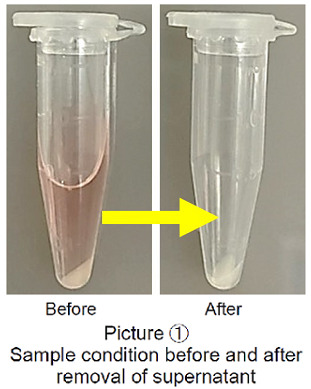
2. Preparation of α-ketoglutarate (α-KG) standard solution
- Mix 10 μl α-KG Standard (10 mmol/l) and 490 μl ddH2O in a microtube to prepare an α-KG Standard solution (200 μmol/l).
- Mix 50 μl α-KG Standard solution (200 μmol/l) and 450 μl Control Buffer in a microtube to prepare an α-KG Standard solution (20 μmol/l). Serially dilute the solution with Control Buffer to prepare solutions of 20, 10, 5, 2.5, 1.25, 0.625, 0.313, 0 μmol/l (Figure 3).

Figure 3. Preparation of α-ketoglutarate (α-KG) standard solutions
3. Measurements
-Step 1-
- Add 50 μl α-KG standard and test sample solutions to separate wells in a 96-well black plate (Figure 4)
- To obtain accurate data, triplicate measurements are recommended.
- Add 20 μl ALT reaction mixture to the α-KG standard solution and test sample (ALT reaction mixture (+)) wells.
- Add 20 μl Reaction Buffer to test sample (ALT reaction mixture(-)) wells.
- Incubate the black plate at 37 °C for 30 minutes.
- Seal the black plate during incubation to prevent evaporation.
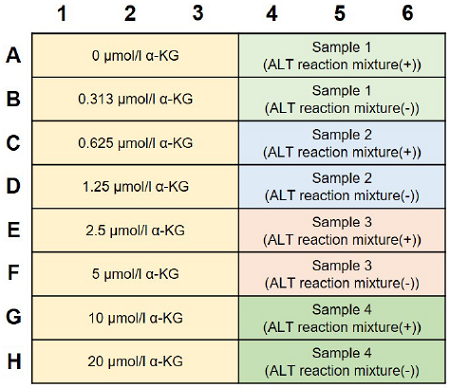
Figure 4. Example of an assay plate format (n=3)
-Step 2-
- Add 50 μl working solution to each well.
- Because the enzymatic reaction starts immediately after the working solution is added, use a multichannel pipette to minimize time lags in pipetting.
- Incubate the black plate at 37 °C for 30 minutes.
- Seal the black plate during incubation to prevent evaporation.
- Measure fluorescence using a microplate reader (Ex: 530-560 nm, Em: 580-600 nm).
- Calculate the α-ketoglutarate concentration in each sample from a calibration curve generated from the α-ketoglutarate standards.
- The α-ketoglutarate concentration is calculated using the equation:
α-ketoglutarate (μmol/l)= (ALT reaction mixture (+))-(ALT reaction mixture (-)) - Multiply the results by the dilution factor to determine the α-ketoglutarate concentration in the original sample.
- The α-ketoglutarate concentration is calculated using the equation:
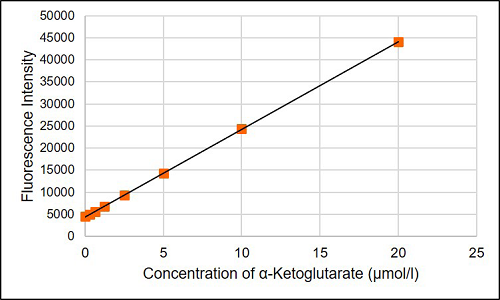
Figure 5. Typical calibration curve generated with α-ketoglutarate standards
Experimental Example
Change in intracellular α-ketoglutarate concentration of doxorubicin-treated A549 cells
- A549 cells were seeded in a 10-cm dish (2×107 cells/dish in DMEM containing 10% fetal bovine serum and 1% penicillin-streptomycin) and cultured overnight in an incubator (37 °C, 5% CO2).
- The medium was removed, and doxorubicin solution (200 nmol/l in DMEM) was added to the dish.
- The cells were cultured for 4 days in an incubator (37 °C, 5% CO2).
- The medium was removed and DMEM was added to the dish.
- The cells were cultured for 2 days at an incubator (37 °C, 5% CO2).
- The medium was removed, and the cells were washed once with 2 ml PBS.
- The cells were trypsinized and collected in a conical tube.
- Doxorubicin-treated A549 cell suspensions (2×106 cells/tube) were prepared in a 1.5 ml microtube.
- Control untreated A549 cell suspensions (2×106 cells/tube) were prepared in a 1.5 ml microtube.
- The supernatants were removed after centrifugation at 300×g for 5 minutes.
- PBS (500 μl) was added to each tube, and the supernatants were removed after centrifugation at 300×g for 5 minutes.
- HCl (10 mmol/l, 80 μl) was added to each tube, and the pellet was resuspended by pipetting. Then the cells were lysed by freezing and thawing three times.
- Lysis Solution (20 μl) was added to each tube, and the cell lysate was mixed by pipetting. Then the solutions were centrifuged at 8000×g for 10 minutes.
- The supernatant (80 μl) was transferred to a new 1.5 ml microtube, and Control Buffer (270 μl) was added to each tube (sample solution). Sample or α-ketoglutarate standard solutions (50 μl each) were added to individual wells of a 96-well black plate.
- ALT reaction mixture (20 μl) was added to α-KG standard solutions and sample (doxorubicin-treated A549 cell lysate and non-treated cell lysate) (ALT reaction mixture (+)) wells.
- Reaction Buffer (20 μl) was added to the sample (ALT reaction mixture (-)) wells.
- The assay plate was incubated at 37 °C for 30 minutes.
- Working solution (50 μl) was added to each well.
- The assay plate was incubated at 37 °C for 30 minutes.
- Fluorescence was measured using a microplate reader (Ex: 535 nm, Em: 590 nm), and the concentration of α-ketoglutarate in the samples was calculated from the calibration curve.
α-ketoglutarate (μmol/l)=(ALT reaction mixture (+))-(ALT reaction mixture (-))
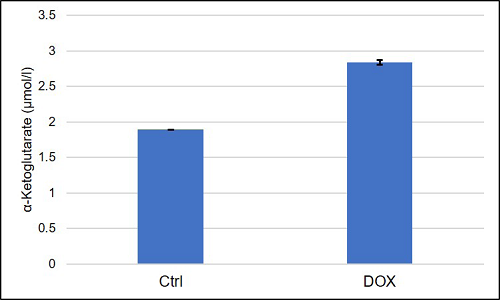
Figure 6. Comparison of intracellular α-ketoglutarate concentration between
doxorubicin (DOX)-treated and non-treated (Ctrl) A549 cells
The intracellular α-ketoglutarate concentration of A549 cells was increased by doxorubicin-treatment.
Reference
- John, P. M. IV. et al., Nature, 2019, 573, 595-599
Frequently Asked Questions / Reference
K261: α-Ketoglutarate Assay Kit-Fluorometric
Revised May., 24, 2023


 Hidden sections will not be printed.
Hidden sections will not be printed.